by Matthew Orwat | Mar 27, 2014
 UF IFAS Washington County Extension is offering a class for the Limited Commercial Landscape Maintenance Pesticide license and the Limited Lawn and Ornamental license.
UF IFAS Washington County Extension is offering a class for the Limited Commercial Landscape Maintenance Pesticide license and the Limited Lawn and Ornamental license.
Click here to download flyer In PDF
Is it the license you need?
If part of your business is applying herbicides (including Roundup) or certain pesticides to plant beds, the State of Florida requires that you have a limited pesticide license. Operating without one could mean a $5,000 fine. Even more, it could increase your liability in case of an accident.
To become licensed, you need to take a 6-hour course and a written exam. If you are like many people, taking the time and money to go through the course, especially if you are uncomfortable with taking the exam, is really difficult. Therefore, you put it off, again and again.
CountyExtension can help
Because we have access to all the University’s resources, we can give you the very best instructors and programs.Extension will make the 6-hour limited pesticide course easy, interesting and useful.
If you already have your license, the following CEU’s can be earned:
2 CEU in L&O, LCLM, O&T, Private Ag.,Commercial Lawn and Ornamental or Limited Urban Fertilizer, plus 2 core.
Class details:
Tuesday, April 22, 8am-4pm
CEU Renewal 8am-2pm
Washington County Agricultural Center
UF IFAS Washington County Extension Office
East Wing Conference Room
1424 Jackson Ave. Chipley Fl. 32428
For information call:
Matthew Orwat
UF/IFAS-Washington County
Horticulture Agent
Email: mjorwat@ufl.edu
(850) 638-6180
To Register Call Matt or Cynthia at (850) 638-6180

by Alex Bolques | Mar 25, 2014
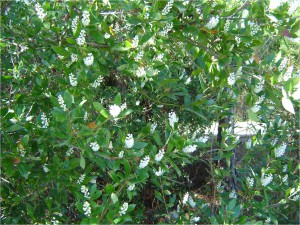
Black Titi in bloom. Flower clusters upright at tips of branches. An excellent source of nectar and pollen for honey production. Image: Alex Bolques
Black Titi (also known as Spring Titi or Buckwheat Tree (Cliftonia monophylla (Lam.) Britton ex Sarg. is a native shrub or tree that can be found growing along streams and boggy areas of the Florida Panhandle. It can tolerate acidic wetland soils and once established can also tolerate dry soils in the landscape. Black Titi can reach 15 – 30 feet in height with 3 – 4 inches of trunk diameter. Its bloom period lasts February through March.
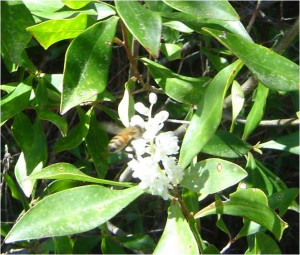
Bee visits a Black Titi flower. Image credit: Alex Bolques
Beekeepers love it because it is a wonderful source of nectar and pollen for honey production. Beginning beekeepers may confuse Black Titi with White Titi (also known as Summer Titi or Swamp Titi (Cyrilla racemiflora L.). It should not be grown as a honeybee pollinator plant. The nectar and/or pollen of White Titi can promote a condition known as “Purple brood”, which can be detrimental to honeybee immature stages.The flower of the spring flowering Black Titi is a raceme, a cluster of flowers along a central stem, that appears as an upright cluster on the tip of branches. The flower of the summer flowering White Titi is also a raceme, not as upright, more elongated. Visit the USDA Natural Resource Conservation Service plant database website and click on the image tab to see Black Titi (Buckwheat Tree) or White Titi (Swamp Titi) to view differences in flower morphology.
by Mathews Paret | Mar 25, 2014
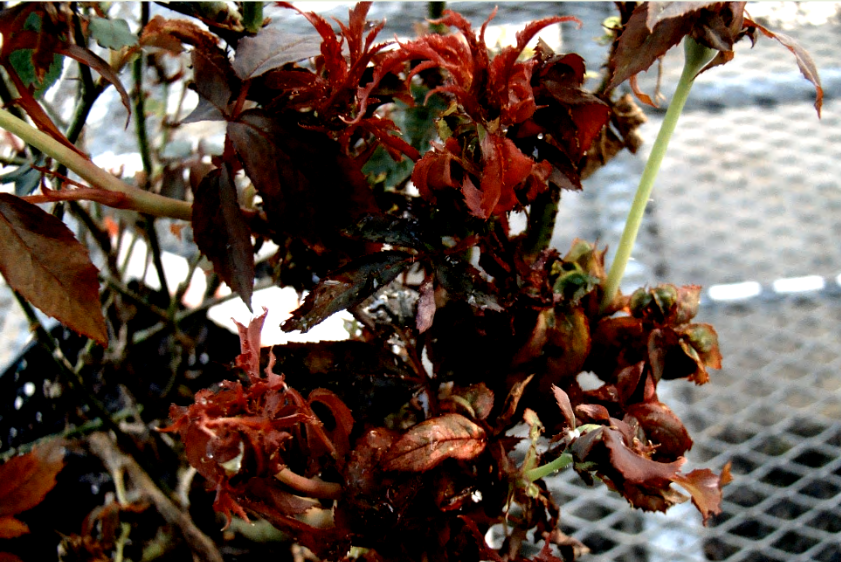
Figure 1. Witches’ broom like appearance, abnormal red discoloration of shoots and foliage, excessive thorns, distorted leaves, and deformed buds and flowers are key symptoms for the devastating Rose Rosette Disease
Roses are one of the most popular flowering shrubs in U.S. with a total wholesale value of 194 million U.S. Dollars. Among the major states in U.S., Florida is the fourth largest producer of roses with a total value exceeding 20 million U.S. Dollars. Among the major diseases on roses, Rose Rosette Disease caused by Rose Rosette Virus (RRV), an Emaravirus has been a major problem for roses in many states in the U.S during the last many years. This virus is spread by an eriophyid mite species Phyllocoptes fructiphilus. This disease was not present in Florida until November 2013, when the disease was first discovered and now confirmed in 3 Florida counties, which include one in the Panhandle. On Wednesday March 19, Horticulturists from throughout the South met at the NFREC in Quincy Florida to discuss detection and control measures that might be used to combat this viral disease.
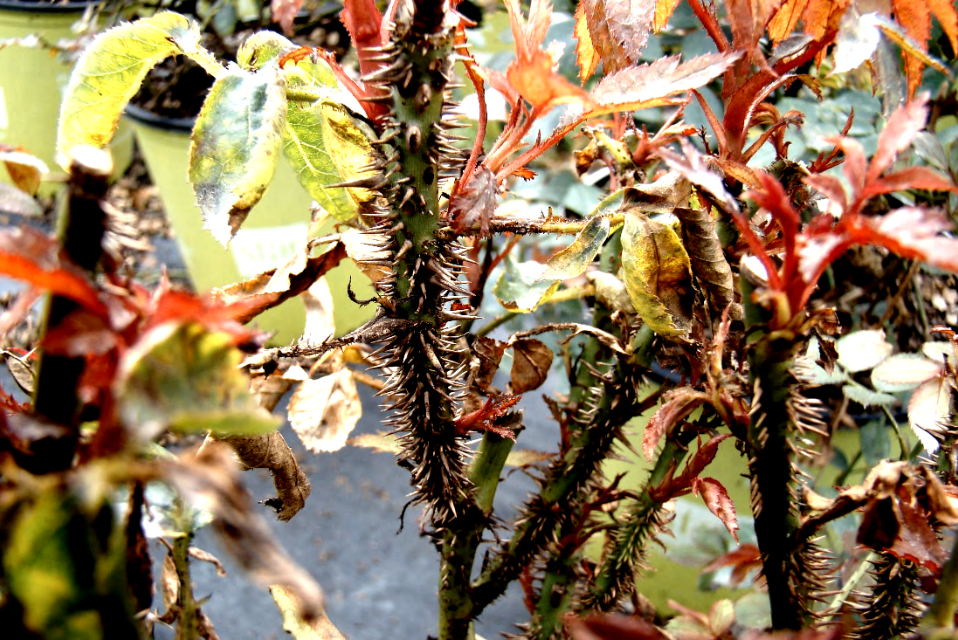
Figure 2. Severe thorn proliferation is another characteristic of rose rosette disease.
The key symptoms for Rose Rosette Disease include witches’ broom, excessive thorns, abnormal red discoloration of shoots and foliage, distorted leaves and deformed buds and flowers (click the link below for symptoms). The diseased plants usually die in 1-3 years. Considering the economic importance of the rose plants, and the highly destructive nature of the Rose rosette virus, research is currently underway by scientists at the University of Florida and the Division of Plant Industry-FDACS to develop early detection methods for the virus and management practices. This project is funded by Florida Nursery Growers and Landscape Association, and the University of Florida, IFAS Dean for Research.
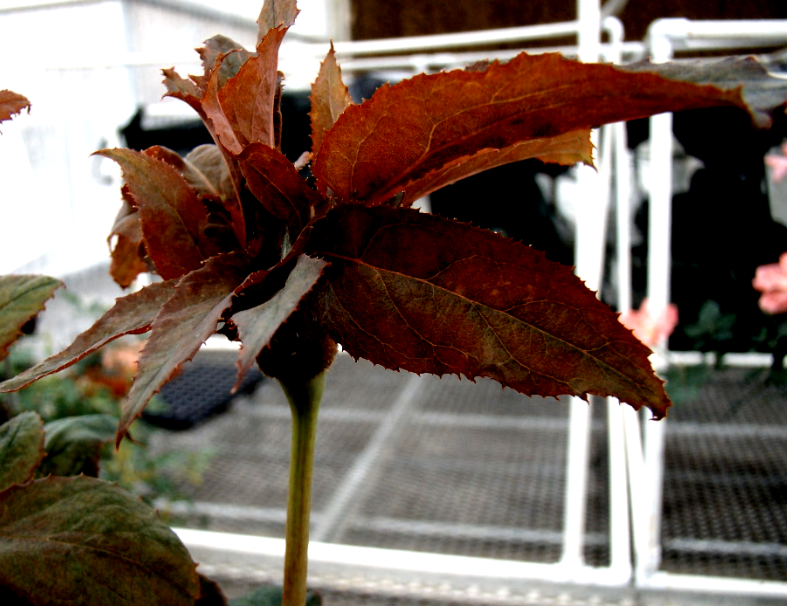
Figure 3. Distorted flower bud; leaf developing from flower bud tissue.
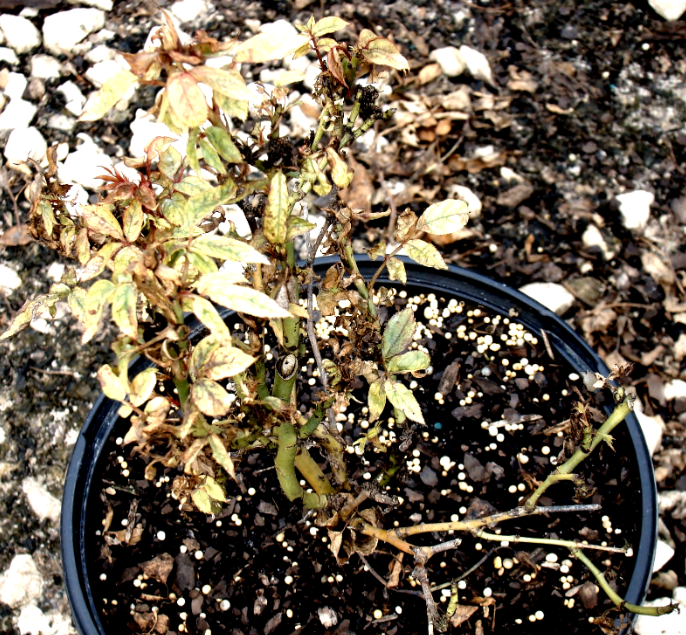
Figure 4. Severe yellowing and stunting of the plant. Infected plants usually die in 1-2 years.
How Home Gardeners and Landscape Professionals Should Respond:
-
Routine scouting and early identification. Submit samples for definitive confirmation.
-
Destroy infected plants. There is no cure for rose rosette disease. Detection will prompt a quarantine by DPI until cleaned up.
-
Eriophyid mite management in early spring is not necessary right now since it has not been found in Florida.
-
Note: The Eriophyid mite species described as the vector for RRV is not known to be present in Florida. Thus mite management recommendations are protective in nature.
Further details can be found in the links below.
U-Scout Pest Alert
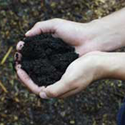
by Roy Carter | Mar 25, 2014

Image Credit UF IFAS Gardening solutions.
What does it mean to grow gardens organically? It depends upon who you talk to. The simple answer is that organic gardeners only use animal or plant-based fertilizers rather than synthetic. It also means use of natural pest control devoid of synthetically manufactured insecticides. In other words, using natural substances and beneficial insects to ward off pests instead of spraying with the backyard equivalent of Malathion. My information on organic vegetable gardening was provided by UF IFAS Extension Publication “Organic Vegetable Gardening” HS 1215.
Why garden organically? Since “USDA Certified Organic” does not apply to home gardening, why would any gardener give up all synthetic fertilizers? And why not use synthetic pesticides, when just one application could eliminate even the most devastating ravages of a crop insect or disease? Why work, so hard handling large quantities or organic soil amendments and manures when synthetic fertilizer of every description and purpose are so quickly available and easy to use?
Early organic gardeners did it to preserve a way of life that reduced pollution and environment decay, thus creating a more ecological society. Organic enthusiasts are extremely health-conscious, and hope that working vigorously outdoors and eating foods free from pesticides just might lead to better nutrition and health.
The biggest differences between organic and conventional gardening are in the area of fertilization and pest control. The organic gardener prefers organic materials and natural methods of dealing with insect problems and fertilizer requirements. The conventional gardener uses a combination of chemically prepared materials and scientific methods in approaching the vegetable garden.
Whichever method you choose, you need to select a plot of good, well-drained soil for planting vegetables. Also, it is important to choose vegetable varieties suited to Florida growing conditions.
Soil preparation is the most important step in organic gardening. Since organic fertilizers and soil conditioning materials work rather slowly, they need to be mixed into the soil at least three weeks ahead of planting time.
To have a successful organic garden, you need to use abundant quantities of organic material, usually in the form of animal manures, cover crops, compost or mixed organic fertilizer. These materials improve the tilth, condition, and structure of the soil. They help the soil hold water and nutrients better. In addition, organic matter supports micro-biological activity in the soil, and contributes major and minor plant nutrients. Another benefit is that as these organic matters decompose, they release acid which help to convert insoluble natural additives, such as ground rock, into forms plants can use.
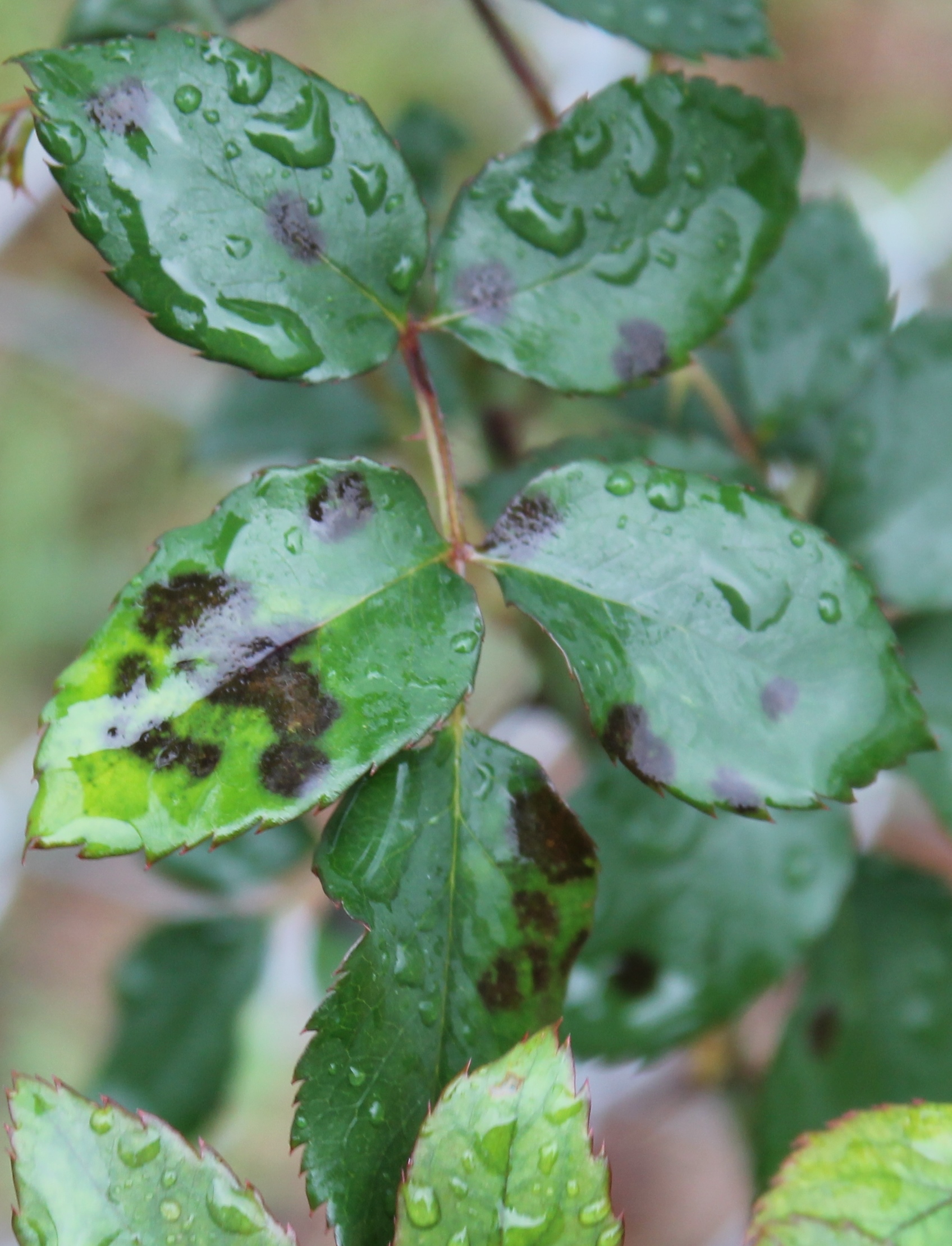
by Matthew Orwat | Mar 18, 2014
March may seem a little early to worry about fungal diseases, but recent prolonged wet weather and warmer temperatures have made the climate just right for a variety of leaf diseases in the Florida Panhandle. One in particular, Blackspot (Diplocarpon rosae), is particularly problematic for the discerning rose grower. Blackspot is just beginning to be seen this season on non-resistant rose cultivars throughout the central Florida panhandle.
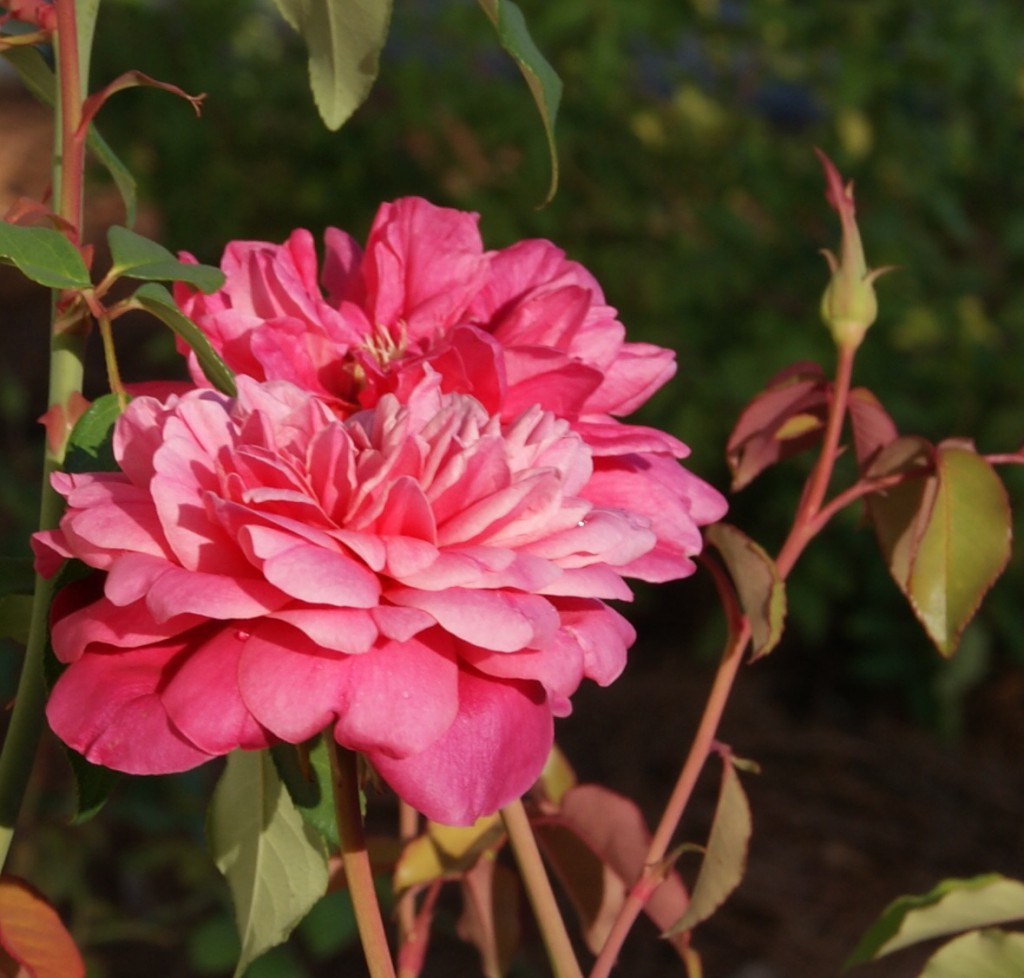
Monsieur Tillier, a rose that shows promise for blackspot resistance, is also part of the Earthkind program. Image Credit Matthew Orwat
Blackspot spores are spread from the canes or leaves of the previous season’s growth by rain or overhead irrigation. To minimize innoculum (black spot spores) remove all leaves from the previous season and any dead leaves at the base of the plant. After the annual pruning in mid to late February, it is a good idea to spray roses with sulfur or copper based fungicidal soap. This helps kill spores that have been laying dormant throughout the winter. Be careful not to spray these products when temperatures rise above 80 ° F. Doing so could burn the plants, although these products will damage tender young growth as well at temperatures below 80 ° F .
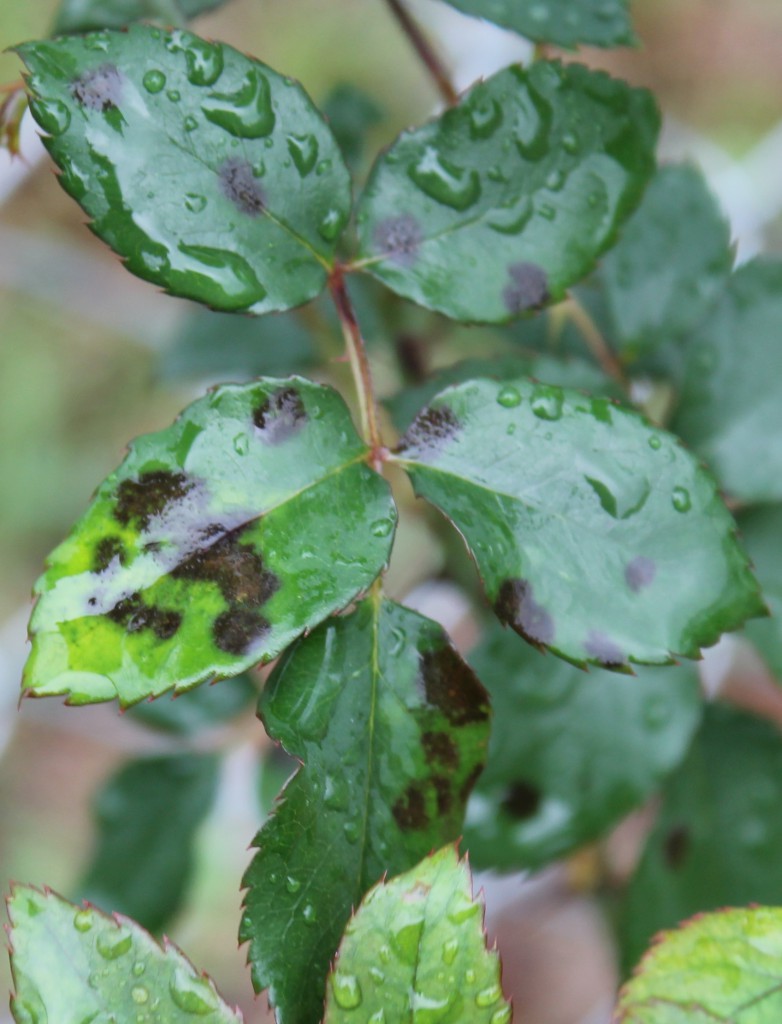
Wet, blackspot affected leaves. Image Credit Matthew Orwat
While dormant sprays often allow rose gardeners to get ahead of the disease, the best defense for the home garden is to plant resistant cultivars. There are several old and new resistant cultivars on the market. Some new resistant cultivars of note include Home Run and Knockout. Also, several older cultivars have demonstrated excellent resistance, such as Mrs. B.R. Cant and Spice. The author has been working with several older rose cultivars at the UF / IFAS Washington County Extension demonstration garden that have shown resistance during the last three years. While this demonstration garden is not a scientific study, several roses that have demonstrated some merit include Belinda’s Dream, Monsieur Tillier, Mme. Antoine Mari, Rosette Delizy and Souvenier de la Malmaison. Another resource for information on disease resistant roses is the Texas Earthkind rose program from Texas A&M University. While disease resistance is not always identical in different parts of the county, their recommended list gives the beginning rose gardener a good place to start.
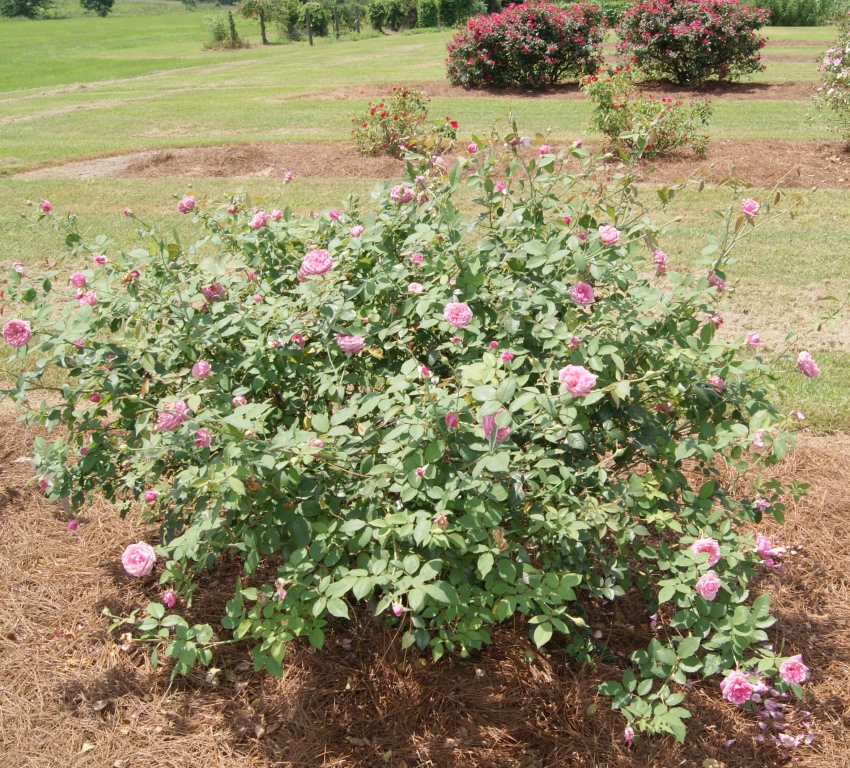
Mrs. B. R. Cant, a tea rose from 1901 has shown very good blackspot resistance at the UF IFAS rose trials in Quincy, FL. Image Credit Matthew Orwat
Several other cultural methods that will prevent spread of this disease among the rose garden include avoiding overhead irrigation, planting in well ventilated areas and proper plant spacing. These techniques attempt to make the garden environment inhospitable for blackspot proliferation.
Regardless if these management techniques are followed, if traditional large, long-stemmed, high maintenance Hybrid Tea roses are desired, most Florida rose gardeners will need to begin a spray schedule to prevent the onslaught of blackspot. Several fungicides are on the market to aid in this process, but remember that they must be used regularly (every 7-14 days) and modes of action must be rotated. This means that different types of fungicide must be rotated so that resistance to a particular fungicide by the blackspot organism does not develop. Below is a table of recommended fungicides for homeowner blackspot control. For more information, please consult the UF IFAS Extension publication P268, Blackspot of Rose.
Fungicide products marketed toward homeowners for control of black spot on roses
|
Active ingredient
|
Fungicide group
|
Trade name
|
|
Copper hydroxide
|
M1
|
Hi-Yield ® Copper |
|
Copper Sulfate
|
M1
|
Bonide® Copper Dust |
|
Copper Octanoate
|
M1
|
Bonide® Liquid Copper, Natural Guard Copper Soap, Ortho® Disease B Gon® Copper Fungicide |
|
Sulfur
|
M2
|
Bonide® Sulfur Dust, Ferti-lome® Dusting Sulfur, Green Light, Hi-Yield® Dusting Wettable Sulphur, Ortho® Bug-B-Gon® Rose & Flower Care |
|
Mancozeb
|
M3
|
Bonide® Mancozeb |
|
Captan
|
M4
|
Bonide® Captan 50WP, Hi-Yield® Captan 50W Fungicide |
|
Chlorothalonil
|
M5
|
Bonide® Fungonil, Ferti-lome® Broad Spectrum, Hi-Yield® Vegetable, Flower, Fruit and Ornamental Fungicide, Monterey, Ortho® Disease B Gon™ Garden Fungicide , Monterey Fruit Tree, Vegetable & Ornamental Fungicide |
|
Myclobutanil
|
3
|
Spectracide Immunox® Multi-Purpose Fungicide |
|
Propiconazole
|
3
|
Ferti-lome® Liquid Systemic Fungicide, Monterey Fungi-Fighter |
|
Tebuconazole
|
3
|
Bayer Advanced™ Disease Control for Roses, Flowers & Shrubs |
|
Tebuconazole + Imidacloprid
|
3 +
|
Bonide® Rose RX Systemic Drench, Feti-lome® 2-N-1 Systemic |
|
Triforine
|
3
|
Ortho® RosePride® Disease Control |
|
Calcium Polysulfide
|
NC
|
Hi-Yield® Lime Sulfur Spray |
|
Neem Oil
|
NC
|
Bonide® RX 3 in 1, Green Light® Neem Concentrate, Green Light® Rose Defense®, Monterey |
|
Acetamiprid + Triticonazole
|
NC + 3
|
Ortho® Bug B Gon® Insect & Disease Control |
|
Acephate + Resmethrin + Triforine
|
NC + NC + 3
|
Ortho® RosePride® Insect, Disease & Mite Control |
| Fungicide Group (FRAC Code): Numbers (1-37) and letters (M) are used to distinguish the fungicidal mode of action groups. All fungicides within the same group (with same number or letter) indicate same active ingredient or similar mode of action. This information must be considered in making decisions about how to manage fungicide resistance. M=Multi-site inhibitors, fungicide resistance is low; NC= not classified. Source: http://www.frac.info/ (Fungicide Resistance Action Committee, FRAC).
Always read a current product label before applying any chemicals.
|
 UF IFAS Washington County Extension is offering a class for the Limited Commercial Landscape Maintenance Pesticide license and the Limited Lawn and Ornamental license.
UF IFAS Washington County Extension is offering a class for the Limited Commercial Landscape Maintenance Pesticide license and the Limited Lawn and Ornamental license.











